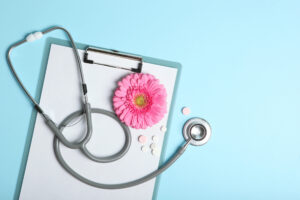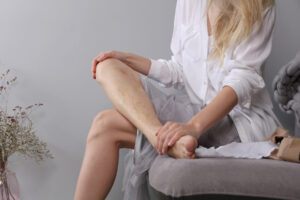By Iris Farrou
31 May, 2021
Women's Health
Best gyns in Buffalo, Best OB practices in Buffalo, Best OBGYN Groups in Buffalo, Buffalo OB-GYN, Buffalo OBGYN, Chouchani MD, WNY OB-GYN, WNY Ob-gyn doctors, WNY OBGYN, women's health
 Vaginitis and bacterial vaginosis are both equally common vaginal infections. While the symptoms experienced may be either completely the same or very similar, the treatments for the two are very different. It may help to understand that bacterial vaginosis is a type of vaginitis, along with yeast infections and trichomoniasis. Additionally, there are some slight differences as far as the symptoms are concerned which may help you distinguish what it may be, should you experience abnormal discharge.
Vaginitis and bacterial vaginosis are both equally common vaginal infections. While the symptoms experienced may be either completely the same or very similar, the treatments for the two are very different. It may help to understand that bacterial vaginosis is a type of vaginitis, along with yeast infections and trichomoniasis. Additionally, there are some slight differences as far as the symptoms are concerned which may help you distinguish what it may be, should you experience abnormal discharge.
Vaginitis
It is caused by a change in the normal levels of vaginal bacteria or by an infection. It may also be caused by some skin disorders or reduced estrogen levels (usually after menopause). Overall, it is an inflammation of the vagina that can lead to itching and discharge, as well as pain during intercourse and urination. It may also lead to vaginal bleeding or spotting.
Vaginosis
Overgrowth of vaginal bacteria cause this vaginal inflammation, which results in discharge of gray, white, or even green color. Itching and pain during urination are also common symptoms, as is foul-smelling vaginal odor. Keep in mind that many people with bacterial vaginosis may not experience any symptoms. It can affect any age, but it is more common on women of reproductive ages.
Diagnosis
Any doctor will probably begin by looking into your medical history and, of course, take into consideration your sexual history to determine risk factors—especially if you have multiple sex partners or a new sex partner. The existence of previous vaginal infections is also a risk factor, as are your hormonal levels. Performing a pelvic exam to check for vaginal inflammation and discharge is also standard procedure. If your doctor is suspecting bacterial vaginosis, it is also likely that they will check your abdomen and pelvic organs for any indication of disease. Taking a sample for lab testing and examination of vaginal secretions and pH helps reach a more detailed diagnosis as well.
Treatment
Depending on the type of vaginitis diagnosed, your doctor will assign different treatments. Yeast infections are the easiest to treat with over-the-counter (OTC) medications, usually anti-fungal creams. Keep in mind that though OTC are convenient and cost-effective ways to treat vaginal abnormalities, the wrong medication can lead to more complications and delay proper diagnosis and treatment.
Bacterial vaginosis may be treated by prescribing Metronidazole, which can be taken orally or as a gel applied into the vagina. Other treatments include: Tinidazole, a prescribed oral medication and Clindamycin, a vaginal gel. Note that vaginosis can spread between female sexual partners, and it is especially important for pregnant women to be treated to avoid early birth or low birth weight.
There is also non-infectious vaginitis to keep in mind, which may be caused by other sources of irritation such as a new soap or laundry detergent, tampons, or sanitary napkins.
More
By Iris Farrou
19 May, 2021
Women's Health
Best gyns in Buffalo, Best OB practices in Buffalo, Best OBGYN Groups in Buffalo, Buffalo OB-GYN, Buffalo OBGYN, Chouchani MD, WNY OB-GYN, WNY Ob-gyn doctors, WNY OBGYN, women's health
 One of the most common concerns of aging women is the appearance of varicose veins on their legs. Varicose veins and spider veins are swollen, twisted veins that are mostly found on the legs and appear more in women because pregnancy tends to increase the risk of having them. Additional factors are older age and obesity. Both types of veins are usually painless, don’t cause health problems, and can be treated for cosmetic purposes. Some people report experiencing aching pain and discomfort, while varicose veins sometimes lead to more serious problems.
One of the most common concerns of aging women is the appearance of varicose veins on their legs. Varicose veins and spider veins are swollen, twisted veins that are mostly found on the legs and appear more in women because pregnancy tends to increase the risk of having them. Additional factors are older age and obesity. Both types of veins are usually painless, don’t cause health problems, and can be treated for cosmetic purposes. Some people report experiencing aching pain and discomfort, while varicose veins sometimes lead to more serious problems.
What is the difference?
Varicose veins are red, blue, or skin colored and seem to have a rope-like texture, while they also tend to cause the skin to bulge out. They are often on the thighs and calves, as well as the inside of the leg near the ankles and feet. During pregnancy they can also happen in the lower pelvic area and the buttocks.
Spider veins are smaller than varicose veins, and predominantly red. They can be seen under the skin, but they do not make the skin bulge. They can from tree-like designs or look like spider webs (hence their name). Most commonly, they are seen on the legs and face.
Symptoms
Other than simply appearing under your skin, you may experience an achy feeling on your legs, muscle cramping, or swelling on your lower legs. Another sign may be worsened pain after either sitting or standing for an extended period of time. Itching or skin discoloration around veins may also be indicative of varicose veins forming.
Risk Factors
- Age: the older you get, the more chances there are of getting varicose veins. Wear and tear on the valves of your veins is normal with age, and eventually the blood may collect back into your veins instead of flowing up to your heart.
- Sex: as stated above, women are more likely to develop varicose veins. Hormonal changes may play a role, as they tend to relax vein walls. Additionally, hormone treatments increase the risk of varicose veins.
- Pregnancy, family history, and obesity are other risk factors you should take into consideration if you are worried about varicose veins in older age.
Prevention
Though you cannot completely prevent varicose or spider veins, as they have to do with normal wear and tear of your vein valves and strength of muscles, there are some ways to minimize the risk of getting them or avoid getting more. Improving your circulation and muscle tone through exercising, watching your weight, lowering salt intake, avoiding high heels, elevating your legs, and avoiding sitting down or standing up for a long time are all ways which may help reduce the risk of varicose veins.
More
By Iris Farrou
09 May, 2021
Breastfeeding support
Benefits of breastfeeding, Best gyns in Buffalo, Best OB practices in Buffalo, Best OBGYN Groups in Buffalo, Buffalo OB-GYN, Buffalo OBGYN, Chouchani MD, WNY OB-GYN, WNY Ob-gyn doctors, WNY OBGYN

If you are an expecting or new mother, you are probably finding yourself wondering about the benefits of breastfeeding, the required—or suggested—length of time for breastfeeding your baby, as well as about storage options and solutions. In this amalgamation of information, one thing is for sure: the decision on whether to breastfeed or not, and for how long, is to be made between you and your baby.
According to the American Academy of Pediatrics, exclusive breastfeeding should take place for six months and continue after solid foods are introduced at least until one year of age. The World Health Organization extends this even further, recommending breastfeeding until two years old or even longer. As far as the beginning of breastfeeding is concerned, both AAP and WHO suggest as early as one hour after birth.
Benefits of breastfeeding
- Important Nutrition and Antibodies: In the first days after birth, you will produce a thick and yellowish fluid high in protein and low in sugar, full of beneficial compounds, colostrum. It is the ideal milk for a newborn’s digestive tract and as the baby grows, your breasts produce more and more milk. Additionally, it contains high amounts of immunoglobulin and other antibodies which help your baby fight off viruses and bacteria. Formula does not provide antibody protection.
- Reducing Disease Risk and Promoting Healthy Weight: Because of the existence of antibodies, breast milk helps prevent most common diseases that affect babies, such as ear and respiratory infections, colds, gut infections and intestinal tissue damage, bowel diseases, and even SIDS, diabetes and childhood leukemia. Since breastmilk promotes the development of different gut bacteria, it also helps prevent obesity and weight gain. A bonus to that is that babies self-regulate their milk intake when breastfeeding, so they are more likely to develop healthy eating habits.
Keep in mind that there are benefits to breastfeeding for mothers as well, linked to lower chances of contracting diseases, helping your uterus contract, as well as burning more calories and helping you lose weight after pregnancy. Probably the most interesting of all is that breastfeeding can tremendously help new mothers with post-partum depression.
Storing and Handling
Before handling breast milk, make sure you thoroughly wash and sanitize your hands. If using a pump to express milk, ensure it is clean and replace any tubing that may seem moldy or suspiciously unclean.
Freshly expressed breast milk should be stored in either breast milk storage bags, or food-grade containers with tight fitting lids. Avoid BPA-containing bottles. Store the milk at room temperature for four hours or less or keep it in the refrigerator for up to four days. Though you can keep it in the freezer indefinitely, it is suggested that you store it for up to six months for best use but 12 months is also acceptable.
More
By Iris Farrou
08 Apr, 2021
Pregnancy, Women's Health
Best gyns in Buffalo, Best OB practices in Buffalo, Best OBGYN Groups in Buffalo, Buffalo OB-GYN, Buffalo OBGYN, Chouchani MD, seasonal allergies, seasonal allergies during pregnancy, WNY OB-GYN, WNY Ob-gyn doctors, WNY OBGYN
Seasonal allergies can be exacerbated during pregnancy. It’s not always the seasonal allergens that cause your body to react, as pregnancy hormones can also be the cause of unexpected, atypical, or more severe histamine production. Pregnancy is already stressful and physically challenging at times: worrying about what you can and cannot eat, consume or drink, and which activities should be avoided. But as far as allergies are concerned, there are plenty of antihistamine remedies available during a healthy pregnancy.
Seasonal Allergies & Your Baby
Even if you never experienced any seasonal allergy symptoms prior to your pregnancy, but are allergically reacting to something, rest assured your baby will not be the slightest bit uncomfortable—despite what you may be experiencing. More importantly, your reactions don’t indicate that your child will be born with allergies.
Different Seasonal Allergies & Pregnancy
There are two types of seasonal allergies during pregnancy: typical spring allergens that begin as early as February, and summer allergies that last until late fall. Pollen is the culprit for seasonal symptomatic reactions. Ragweed, grass, mold, tree pollen, and other regional pollen-producers can thankfully be avoided and there are healthy ways to soothe your symptoms.
Other pregnancy-related reactions are not caused by your environment: a condition called “Rhinitis of Pregnancy,” usually experienced during the third trimester, is caused by hormone level changes that mimic reactions to seasonal pollens. If you experienced season allergies prior to pregnancy, they may potentially worsen while pregnant. Fortunately, there are many safe ways to treat the reactions.
Treating Seasonal Allergies in Pregnancy
First, stay informed by checking your local pollen forecasts on weather and news apps. You may know some pollens to avoid, but your body can react to new irritants. Wear protective masks while doing outdoor activities like gardening or mowing, and make sure to shower and change clothes once inside. Stay indoors when pollen counts are highest, usually between 5am and 10am.
If you’re experiencing symptoms, saline nasal spray is a safe, effective treatment. It’s important to not use them more than three days in a row, as overuse can worsen nasal congestion. Wearing nasal strips at night opens breathing pathways and leads to a better night’s rest.
Avoidance is always the best form of treatment, but there are over the counter safe medications:
- Benadryl (diphenhydramine) is most recommended
- Zyrtec (cetirizine)
- Claritin (Loratadine)
- ChlorTrimeton (Chlorpheniramine)
Allergy shots, if begun prior to pregnancy, are usually safe to continue. It’s best not to start any allergy treatment during your pregnancy if you aren’t sure how your body will react. As always, should you experience abnormal symptoms of allergies—or severe reactions to allergy medications—while pregnant, reach out to your doctor.
More
As schools begin to increase the amount of in-person instruction, safety measures should still be in place. Experts advise that we keep COVID-19 precautions meticulously, so we may be seeing the next school year starting with necessary safety measures.
Explaining Safety Measures to your Kid
- Teach them about COVID: Kids are more likely to follow safety measures if they understand why: what the virus is, how it spreads, and its seriousness. You should use kid-friendly language to explain a global pandemic, and school kids should understand the virus is something dangerous that goes from one person to another, consists of invisible particles, makes people sick, and can be transmitted from an asymptomatic person.
- Model Behavior: Remember that your kids see you as a role model: it matters more what you do than what you tell them to do. Practice safety habits at home and set an example that your kids are likely to follow even when you are not around or supervising them.
- Promote Mask Wearing: Though this may be taken for granted, we need to remember that children experience masks differently from adults. Definitely teach your children how to wear a mask properly, but keep in mind, to them a mask is a nuisance or an item to play with. Consider letting your children choose their masks so they feel they are participating and let them decorate their masks—a practice that makes them feel proud of the results, and therefore increases the chances of them taking care of their masks.
- Encourage Safe Distancing: Children are naturally drawn to social interactions and if they like experiencing the world in tangible ways the risk of infection is augmented. You can promote group activities and sports that make social distancing easier, while still maintaining comradeship: bike riding, hopscotch, skateboarding or an obstacle course are some suggestions.
Integrating Changes
The safety measures outlined above combine the “new reality” under COVID with elements kids are used to. Just like adults, children can adjust their perspective through understanding the necessity for new habits. As far as the return to school is concerned, since there are so many new elements to get used to, you can alleviate some of the stress by keeping a semblance of normalcy in the following standard, i.e. pre-Covid, ways.
- Prepare for the first day of school by purchasing school supplies, becoming familiar with the school and classrooms, attending orientations, and getting to know the teachers (probably virtually).
- Practice the school route with your kid: whether that is driving them, walking them, biking with them, or preparing them to do the route alone in the future, do a few trial runs with your kid before the big day.
- Consider implementing the school sleep schedule earlier than usual, so that if there are home-school or half days your child’s routine is not terribly disrupted.
More
By Iris Farrou
08 Apr, 2021
Lifestyle Tips, Mental Health
Best gyns in Buffalo, Best OB practices in Buffalo, Best OBGYN Groups in Buffalo, birth control, Buffalo OB-GYN, Buffalo OBGYN, Chouchani MD, mental health tips, WNY OB-GYN, WNY Ob-gyn doctors, WNY OBGYN, women's health
The conversation around the side effects of hormonal birth control and contraceptive pills on mental health has been around for a while: you may have heard women recounting their negative experiences with heightened depression symptoms, or mood swings, when switching contraceptive methods. Though personal experiences are not medical research, they do warrant attention.
In 2016 a Danish study of more than 1 million women, which focused on analyzing nationwide health records, showed that women using hormonal birth control were more likely to be treated for depression. On the other side, studies conducted in the US and Finland have showed that hormonal birth control users report less symptoms of anxiety and depression. Though just what effect hormonal birth control can have on mental health differs, one thing is for sure: it does affect it.
Hormones and Mental Health
Though there are no mental health risks directly associated with the use of contraception, we do know hormones—and hormone imbalances—can have an impact on mental health. To start with, women are twice as likely as men to suffer from depression: this is a difference that starts in adolescence due to the changing levels of estrogen.
During the follicular phase, which is the time between the start of a period and ovulation, estrogen levels are high. However, individuals with depression demonstrate lower levels of estrogen at that time. Hormonal birth control is likely to affect the natural levels of hormones in someone’s body, and therefore cause mental health changes.
Types of Hormonal Contraception and their Effects
Implant
There are two types of implants: one containing the progestin etonogestrel and another containing the progestin levonorgestrel. Results of the Danish study concluded that use of the etonogestrel implant led to higher use of antidepressants, especially for teens. People using that for two years have also reported mood swings and depression attributed to the implant. The risk for depression seems to heighten with the etonogestrel implant, but studies remain somewhat inconclusive.
Hormonal IUD
The Danish study on hormonal IUD showed that adolescent IUD users were more likely to be treated for depression than adult IUD users. However, a Finnish study suggested that women using this method were just as likely to showcase symptoms of anxiety and depression as women who were not using it. Like the implant, there is some evidence that IUD increases chances of depression but no direct conclusion.
Pills
Combined Oral Contraceptives (COCc) contain both synthetic estrogen and progestin. Though the Danish study found that users of COCs aged 16-31 were more likely to be prescribed an antidepressant, several other studies have shown that birth control users are not more likely to have symptoms of depression. However, people using COCs for reasons other than birth control have been found more likely to have depression.
There are several other hormonal contraceptive methods that can potentially affect mental health, but the three examined above are the most commonly used. Results may remain inconclusive, but if you are taking a hormonal contraceptive method and you experience unusual symptoms, you may consider consulting your doctor or healthcare provider.
More
By Iris Farrou
21 Mar, 2021
Menstruation
Best gyns in Buffalo, Best OB practices in Buffalo, Best OBGYN Groups in Buffalo, Buffalo OB-GYN, Buffalo OBGYN, Chouchani MD, Normal menstruation cycle, WNY OB-GYN, WNY OBGYN, women's health tips

When your doctor asks when your last cycle was, there’s no need to jog down memory lane, as you can simply open an app on your smartphone. Cycle tracking apps are helpful with everything from monitoring mood and fertility to alerting us of reproductive system illnesses. If you search for “period tracker” in your app store, the 50+ choices can seem overwhelming.
Here’s a list of favorite cycle tracking apps:
Clue Period & Cycle Tracker
Clue has been accredited by the Obstetrics & Gynecology Journal (ACOG) as the Top Free Period Tracking App, the Best Fertility App by Healthline, and App of the Day Worldwide by the Apple App Store. Clue is female-led and doctor recommended. It lets you log cramps, mood fluctuations, sex drive, sleep schedule, food cravings, and over 30 other categories. The more consistently you log your cycle, the more accurately the app predicts your body’s rhythm. It also alerts you when certain changes or fluctuations may indicate a health issue. Clue’s custom push notifications notify you with shocking accuracy to events like the beginning of your cycle, ovulation, and PMS.
Life – Period Tracker Calendar
This sleek app integrates with HealthKit, allowing you to synchronize your custom data with your phone’s Health App. You can track nutrition, fitness, moods, weight, medication, and more in the most customizable app available. Life also integrates irregular cycle support and allows you to keep separate entries for each symptom so as to easily share it with your physician at a later time. Additionally, you can prevent false alerts about irregularities that may not concern you by personalizing your cycle length. Life is backed and used by licensed physicians, gynecologists and has over 50,000 glowing reviews.
Glow Period and Fertility Tracker
Glow is modern care for your fertility, plus tracking for over 40 different biological symptoms. “Glow Scoops,” a resource section built into the app, has an expansive library of informational articles on topics like egg freezing and menstrual health. You can also export custom PDF reports of your ovulation or fertility health charts to simplify the pregnancy process, and join support communities for issues like IVF, IUI, and natural pregnancy. Glow has a team-based mentality, including generating personal data that your medical care professionals can use to better know your body, and diagnose health issues early and efficiently.
Eve Tracker App
With a recently redesigned Cycle Chart, Eve is a savvy period tracker and sex app for women looking to take control of their health and sex lives. Eve is a spicier type of tracking app that includes the typical interactive tracking data, and also has daily sex quizzes so you can own your cycle and feel good in bed. The interactive staircase helps you see your menstrual history in a new light and has a community of women that discuss sex and health issues. Eve is also compatible with the Health app and has an interactive calendar view for every step of your cycle.
More
By Iris Farrou
19 Mar, 2021
Queer Health, Sexual health, Women's Health
Best gyns in Buffalo, Best OB practices in Buffalo, Best OBGYN Groups in Buffalo, Buffalo OBGYN, Chouchani MD, queer health, WNY OB-GYN, WNY Ob-gyn doctors, women's health

Many of the gynecological health issues associated with heterosexual women are also concerns of queer women, including homosexual and bisexual women. However, because queer women are not generally concerned with mainstream gynecological health issues, such as pregnancy and contraception, they may find it difficult to receive adequate support from healthcare professionals, or access unbiased and non-discriminatory resources. It should also not be forgotten that minority populations tend to experience higher levels of social anxiety, stress, and depression. As such, the higher levels of mental healthcare that queer women need, along with the lack of resources targeted specifically to them, places them at a precarious position when it comes to sexual and gynecological health.
Gynecological Care Tips
While the following tips and areas of concern to be noted may not apply to everyone, as sexual health depends on sexual preferences, family history, overall health, and health among other factors, these have been identified as the most common areas of concern among queer women.
- Bacterial Vaginosis: Lesbian women that seek care for bacterial vaginosis at women’s health clinics have been found to be twice the rate compared to heterosexual women. Bacterial vaginosis has been found to be associated with a higher number of female sexual partners, though its transmission mechanism is only hypothesized to be oral sex.
- Yeast Infection: Though not identified as a sexually transmitted infection, yeast infections can occur through direct skin contact with someone who harbors the organism. As far as lesbian sexual relations are concerned, this transmission may occur due to vulva-to-vulva connection, or through the transmission of the bacteria from the fingers to the vagina.
- Herpes, HPV, Hepatitis: Common as these are, they are also present in queer women’s intimate relationships—vaccinations against these infections, as well as practicing safe sex and maintaining personal hygiene and health minimize the risk of contraction.
Mental Health Care Tips
Sexual minorities do not only experience higher levels of stress and depression, but they also experience social discrimination and isolation. This can lead to a conglomeration of mental health issues, but most notably it tends to lead to queer women remaining silent when it comes to domestic abuse and intimate partner violence.
This silence is primarily associated with the general misconception that abuse is present only in heterosexual relationships, and it is also attributed to fear of discrimination. Though the discrimination and the experienced violence may be directly related, as queer women have been found to experience mental, physical and verbal abuse that targets their sexual orientation, it may also be indirect. Lack of training in part of service providers or discrimination in shelters create more difficulties for queer women who seek support against intimate or domestic violence, which in turn leaves them in abusive situations for a longer period of time.
It should also be taken into consideration that the fear of being “outed,” not receiving adequate support from health providers, friends, and family, or the fear of social and intimate isolation are factors that contribute to the higher rates of violence and abuse in queer women’s relationships. If you are experiencing partner violence, consider reaching out for support to a trusted individual, or conducting research on domestic violence support that may assist you in creating a plan to leave the abusive environment.
More
By Iris Farrou
08 Mar, 2021
Heart health
Best gyns in Buffalo, Best OB practices in Buffalo, Best OBGYN Groups in Buffalo, Buffalo OB-GYN, Buffalo OBGYN, Chouchani MD, WNY OB-GYN, WNY Ob-gyn doctors, WNY OBGYN, women's heart health

Though we may be more concerned with heart attacks in general, it is important to remember it is just one condition associated with the umbrella of heart diseases, which may also include coronary artery disease, valve disease, or rhythm problems—among others.
Causes and Symptoms
The cause of a heart disease may depend on one or more of the following risk factors:
- Diabetes: Women with diabetes have higher chances of developing heart disease than men. Additionally, because diabetes changes the way one perceives pain, it also increases the chances of a silent heart attack.
- Stress and depression: In addition to making it difficult overall to have a healthy lifestyle, stress has been found to affect women at a higher percentage than men when it comes to heart health.
- Smoking and inactivity: Undeniably the causes of myriad health problems, smoking and lack of physical activity directly influence heart health in women negatively.
- Menopause: A cause for concern after menopause is the low estrogen levels, which may lead to heart disease in smaller blood vessels.
- Pregnancy complications: Women’s long-term risk of high blood pressure and diabetes may be augmented if such health conditions make themselves present during pregnancy.
- Family history: History of early heart disease appears to be a higher risk factor in women than in men.
Symptoms of heart disease should be taken seriously, and be followed up with consultation with a medical professional, especially as they may resemble day-to-day symptoms of fatigue:
- Pain in the neck, jaw, or throat
- Sharp chest pain or discomfort, but also dull and heavy pain
- Pain in the back or upper abdomen
- Nausea, vomiting, and fatigue
- Indigestion and heartburn
- Chest palpitations
- Shortness of breath and swelling of the feet and ankles
Misdiagnosis
The two main reasons for misdiagnosed heart disease in women is that it is typically thought of as a male problem—despite it being the number one cause of death of American women—and that the symptoms are sometimes dismissed as something less serious.
A study conducted in 2018 found that 62% of women reported more than three symptoms that were not associated with the chest area or with chest pain, compared to 54.8% of men. Additionally, 53% of women in the study confessed to their doctors or health providers dismissing the symptoms as not associated with heart disease. Only 36.7% of men in the study reported their health provider treating their symptoms as something less.
Health Tips
Maintaining your overall health is important in preventing heart disease, but you may want to pay more particular attention to alcohol consumption and smoking, as well as add regular exercise to your routine. Managing and lowering stress levels and depression is also optimal, as is a diet that assists your overall health.
More
By Iris Farrou
26 Feb, 2021
Lifestyle Tips, Sexual health
Best gyns in Buffalo, Best OB practices in Buffalo, Best OBGYN Groups in Buffalo, Buffalo OB-GYN, Buffalo OBGYN, Chouchani MD, WNY OB-GYN, WNY Ob-gyn doctors, WNY OBGYN, women's health

According to the CDC, human papillomavirus (HPV) is the most common sexually transmitted infection (STI), while other sources report that about 14 million people become infected every year. Both men and women can contract HPV. It is estimated that though 80% of sexually active individuals are likely to have it during their life, not all of them know they have the virus. Some types of the virus can cause warts or cancer, while other types go away on their own. However, contracting the disease once does not exclude one from getting it again.
Causes and Transmission
HPV can be transmitted relatively easy when skin on skin contact with someone who has it occurs. Most commonly, this occurs with sexual contact and during vaginal or anal sex. It may also be transmitted during childbirth, from the mother to her baby. In many instances, HPV causes no symptoms, which can make it rather hard to even suspect its presence. Additionally, if you have contracted the virus it can take years to show any symptoms so identifying when you first became infected becomes a challenge. The most common symptom is warts, which are usually bumps in the genital area—either flat or raised. In other cases, when the virus does not go away it can cause different types of cancer.
It is recommended that you not only get tested regularly for STIs, and keep up with Pap smears, but that you also specifically request an HPV test. Regular Pap smear results do not exclude the possibility of HPV; in ages over 30, you may also want to consider screening for cervical cancer.
HPV and Cancer
Like with other symptoms of HPV, it can take many years after it is contracted to form into a type of cancer. Usually, the virus causes cervical cancer but it can also cause cancer of the vulva, penis, or anus. It may also cause oropharyngeal cancer, which is located at the back of the throat, base of the tongue and tonsils.
Though there is no cure for HPV itself, there are treatments for warts and for different types of cancer. The most usual treatments for women include colposcopy, where the cervix is closely examined for pre-cancerous cells, cryotherapy which freezes and removes pre-cancerous cells from the cervix, and Loop Electrosurgical Excision Procedure (LEEP) the removes the pre-cancerous cells using an electrical current.
HPV Prevention and Vaccine
Similar to the prevention of any STI, limited sexual contact, safe sexual practices, and regular health checks are good measures to stay safe. The HPV vaccine, however, increases chances of preventing warts and cervical cancer caused. Though the HPV vaccine recommended age is 11 to 12 years old and before the existence of sexual contact, it is still possible to get the vaccine even if you are sexually active already. Remember that the HPV vaccine does not protect against all types of cervical cancer and in most cases it is given in three separate shots.
More
 Vaginitis and bacterial vaginosis are both equally common vaginal infections. While the symptoms experienced may be either completely the same or very similar, the treatments for the two are very different. It may help to understand that bacterial vaginosis is a type of vaginitis, along with yeast infections and trichomoniasis. Additionally, there are some slight differences as far as the symptoms are concerned which may help you distinguish what it may be, should you experience abnormal discharge.
Vaginitis and bacterial vaginosis are both equally common vaginal infections. While the symptoms experienced may be either completely the same or very similar, the treatments for the two are very different. It may help to understand that bacterial vaginosis is a type of vaginitis, along with yeast infections and trichomoniasis. Additionally, there are some slight differences as far as the symptoms are concerned which may help you distinguish what it may be, should you experience abnormal discharge.








